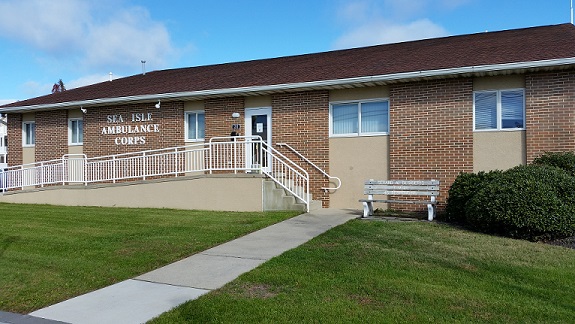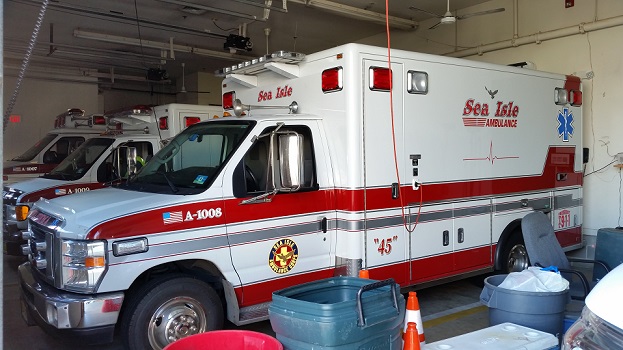Not all of the volunteers have enough time to devote themselves to a full, 12-hour ambulance shift, leading to staffing shortages.
 By Donald Wittkowski
Sea Isle City is moving ahead with plans to create a full-time ambulance service instead of continuing to rely on a dwindling number of volunteers to respond to emergencies.
City Council voted Tuesday to hire a consulting firm to oversee the transition from a volunteer ambulance squad to a professional emergency medical services unit that would be under the town's control.
In October, a consulting firm submitted a report that recommended having the city take charge of emergency services amid a declining number of volunteers in the ambulance squad. That firm, EMS Consulting Services of Hammonton, will now supervise the transition plan.
City officials declined to characterize the plan as an outright takeover of the ambulance corps because volunteers will be used to supplement the full-time emergency workers as part of a "hybrid" force.
"We don't want to call it a takeover," said Paul Baldini, the city solicitor. "We want to work with the ambulance corps to reposition emergency services as a division of the city."
By Donald Wittkowski
Sea Isle City is moving ahead with plans to create a full-time ambulance service instead of continuing to rely on a dwindling number of volunteers to respond to emergencies.
City Council voted Tuesday to hire a consulting firm to oversee the transition from a volunteer ambulance squad to a professional emergency medical services unit that would be under the town's control.
In October, a consulting firm submitted a report that recommended having the city take charge of emergency services amid a declining number of volunteers in the ambulance squad. That firm, EMS Consulting Services of Hammonton, will now supervise the transition plan.
City officials declined to characterize the plan as an outright takeover of the ambulance corps because volunteers will be used to supplement the full-time emergency workers as part of a "hybrid" force.
"We don't want to call it a takeover," said Paul Baldini, the city solicitor. "We want to work with the ambulance corps to reposition emergency services as a division of the city."
 Kris Lynch, a 25-year member of the volunteer ambulance corps and its chief for the last three years, called the transition plan to professional services "vague."
The city has left open the possibility of returning to a volunteer ambulance squad in the future.
"We've told them from Day One that you can take back the service if you can find enough volunteers," Baldini said.
Kris Lynch, a 25-year member of the volunteer ambulance corps and its chief for the last three years, called the transition plan to professional services "vague."
The city has left open the possibility of returning to a volunteer ambulance squad in the future.
"We've told them from Day One that you can take back the service if you can find enough volunteers," Baldini said.
 Not all of the volunteers have enough time to devote themselves to a full, 12-hour ambulance shift, leading to staffing shortages.
Business Administrator George Savastano said that for 28 months, the city has had to approve emergency funding resolutions to help keep the volunteer ambulance corps in operation. In addition to paying volunteers on a per-diem basis, the city also uses some of its full-time municipal workers to supplement the ambulance service.
Not all of the volunteers have enough time to devote themselves to a full, 12-hour ambulance shift, leading to staffing shortages.
McSweeney said it costs about $573,000 annually to run the volunteer ambulance squad. The city pays nearly half the cost, or about $278,000 per year.
He believes the city would pay about the same amount for a professional ambulance service staffed by full-time employees and a chief.
McSweeney said the city could generate $138,000 in annual revenue by hiring an outside firm to handle third-party billings for people who use the ambulance service. That revenue, in turn, would help pay for a full-time ambulance corps and keep the city’s costs about the same as they are now, he noted.
Savastano estimated that it would take several months to complete the transition. Members of the volunteer ambulance corps have been invited by the city to serve on a transition committee.
Kris Lynch, who has served as chief of the volunteer ambulance squad for three years, called the transition plan "vague." She wants more information about what role the volunteers would play in providing emergency services in the future.
"It looks to be more of a supporting role in the whole realm of things," Lynch said.
Sea Isle's volunteer ambulance corps was established in 1956. Lynch said there are currently about 40-45 members, although not all of them are EMTs.
According to Lynch, the ambulance squad hasn't suffered from a decline in the overall number of volunteers. Instead, the problem stems from the volunteers not having enough time to devote themselves to a full, 12-hour ambulance shift, she said.
Lynch has been a member of the volunteer ambulance corps for 25 years. She said she would be open to the idea of becoming the new full-time ambulance chief if the job is offered to her by the city.
"I've been doing this for 25 years. My decision is to do what is best for the town," she said. "I want to have the same faces here and have the same hometown feel."
Not all of the volunteers have enough time to devote themselves to a full, 12-hour ambulance shift, leading to staffing shortages.
Business Administrator George Savastano said that for 28 months, the city has had to approve emergency funding resolutions to help keep the volunteer ambulance corps in operation. In addition to paying volunteers on a per-diem basis, the city also uses some of its full-time municipal workers to supplement the ambulance service.
Not all of the volunteers have enough time to devote themselves to a full, 12-hour ambulance shift, leading to staffing shortages.
McSweeney said it costs about $573,000 annually to run the volunteer ambulance squad. The city pays nearly half the cost, or about $278,000 per year.
He believes the city would pay about the same amount for a professional ambulance service staffed by full-time employees and a chief.
McSweeney said the city could generate $138,000 in annual revenue by hiring an outside firm to handle third-party billings for people who use the ambulance service. That revenue, in turn, would help pay for a full-time ambulance corps and keep the city’s costs about the same as they are now, he noted.
Savastano estimated that it would take several months to complete the transition. Members of the volunteer ambulance corps have been invited by the city to serve on a transition committee.
Kris Lynch, who has served as chief of the volunteer ambulance squad for three years, called the transition plan "vague." She wants more information about what role the volunteers would play in providing emergency services in the future.
"It looks to be more of a supporting role in the whole realm of things," Lynch said.
Sea Isle's volunteer ambulance corps was established in 1956. Lynch said there are currently about 40-45 members, although not all of them are EMTs.
According to Lynch, the ambulance squad hasn't suffered from a decline in the overall number of volunteers. Instead, the problem stems from the volunteers not having enough time to devote themselves to a full, 12-hour ambulance shift, she said.
Lynch has been a member of the volunteer ambulance corps for 25 years. She said she would be open to the idea of becoming the new full-time ambulance chief if the job is offered to her by the city.
"I've been doing this for 25 years. My decision is to do what is best for the town," she said. "I want to have the same faces here and have the same hometown feel."